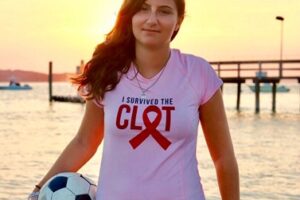I can still remember sitting alone in the emergency room sending funny selfies to my Mom. Why not? I lived in Pennsylvania and she was in North Dakota, and, of course, she was worried. I, on the other hand, was annoyed. Everything started with terrible lower left back pain that eventually moved to my left lower groin. I had no swelling, but by the time I arrived at the ER, my left leg felt a little heavy, and I was extremely exhausted. I was a single mom, and it was almost Christmas, so exhausted was normal! I didn’t think too much about it. I assumed it was a kidney infection, and the doctors thought it might be a twisted ovary. Little did I know, we were both wrong, and my life would soon be flipped upside down.
“Your ultrasound did not show anything, but your CT did. You have blood clots in your left leg. We are always worried that they can break off and travel to your lungs, and unfortunately, that has also happened.” Tunnel vision was next. Everything faded away and the tears started streaming down my face. All I could think of were my kids. I was 31 years old with three kids. I was 31 years old, and healthy – completely healthy. I was running and doing spinning class. Questions flooded my mind. How could this be happening to me? How could blood clots happen to me? Do I have enough life insurance? Will I make it out of the hospital? The only thing I knew for sure about blood clots was that people die from them. I felt numb.
 A couple scans later and the extent of my clots was more clear. My left leg was almost 100% clotted from abdomen to ankle. My iliac and femoral veins were full of clots, and I had at least three pulmonary embolisms, or blood clots in my lungs. I had a filter placed (and eventually removed), and tPA or clot-busting treatment administered in the ICU. The clot turned out to be too extensive for tPA, so my internal radiologist performed a thrombectomy, which removed all the clots from my leg. My iliac vein was so damaged that he also placed an iliac stent. That stent is what essentially resolved my condition.
A couple scans later and the extent of my clots was more clear. My left leg was almost 100% clotted from abdomen to ankle. My iliac and femoral veins were full of clots, and I had at least three pulmonary embolisms, or blood clots in my lungs. I had a filter placed (and eventually removed), and tPA or clot-busting treatment administered in the ICU. The clot turned out to be too extensive for tPA, so my internal radiologist performed a thrombectomy, which removed all the clots from my leg. My iliac vein was so damaged that he also placed an iliac stent. That stent is what essentially resolved my condition.
My local doctors could not determine the cause of my clots. My OBGYN said there is no way it was birth control. I was on the lowest dose and my clotting was too extreme. I eventually traveled to the Mayo Clinic in Minnesota, where I was diagnosed with May-Thurner Syndrome. It is an anatomical condition where the iliac artery compresses the iliac vein against the spine and creates a kink, like a hose. My back pain was due to the pressure and the most extensive clotting was in my groin, at the compression site. I had no idea I had this condition. The doctors said that if I had waited another day, I likely would not have made it.
It has been eight years since then, and physically, I am back to myself. I have a vascular checkup annually and my stent is perfect. I still have times where I’m fearful. It’s difficult to imagine your life being taken away when you never saw it coming. That fear is something that will always be there, but I have learned to manage it. I know that I am lucky to have come out the other side so healthy.
I decided to use my experience to help others. I am getting ready to start my second semester of nursing school. Nurses care for people who are in a dark place, just as I was. My experience has shown me that it’s okay to be scared, but you can’t stay there. When we are faced with an illness we need to lean on those around us, get the best care we can, and then use our experiences and stories to help others. There are people like me who may just be starting a similar journey. It’s important that you know you aren’t alone. It’s okay to be scared, it’s okay to feel alone, and it’s okay to be mad. Stand in your feelings and let them shape you. You will come out the other side different, but I promise you, you will be stronger. Your story will be the hope that someone else needs.
MORE INFORMATION AND RESOURCES:
- Join our online peer support community to connect with other people who have experienced a blood clot.
- Read more about May-Thurner Syndrome.
- Read more stories, or share your story with NBCA.




